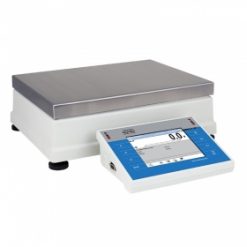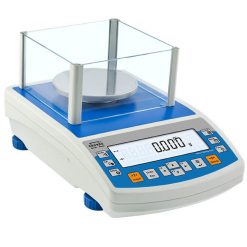Radwag PS 4500.R2.M Precision Balance
OVERVIEW
Readability [d]: 0.01g
PS R2.M is a series of standard-class precision balances of high resolution based on RADWAG MonoBLOCK® technology. The innovative construction of PS R2.M balance features a new single-point weighing pan fastening, which ensures its excellent geometry and minimizes eccentricity error. The labyrinth-shape fastening guarantees excellent resistance to contamination.
RADWAG MonoBLOCK® technology enables weighing
loads with the readability of d=0.01 g at the maximum capacity of 10 kg. Rigid base ensures stability of the weighing system and great resistance to shocks.
Internal adjustment system means precision and high measurement repeatability. Leverage of internal weight mass enables adjustment within the whole measuring range.
Features:
- d=0.01g readability at 10 kg max capacity
- great resistance to ambient conditions
- stability and repeatability over time
- RADWAG MonoBLOCK® technology
- internal adjustment within the whole measuring range
- four databases and ALIBI memory
- easy-to-read LCD display and clear information layout
- quick access keys
Databases
The instrument enables saving completed measurement data as reports and graphs.
The data is stored in databases:
- Operators (max 100 entries),
- Products (max 1 000 entries),
- Weighings (max 5 000 entries),
- Tares (max 100 entries),
- ALIBI memory provides data safety and enables automatic measurement recording (max 100 000 weighing records).
Communication
PS R.M series is equipped with the following interfaces: 2 x RS 232, USB type A and B and optional Wireless Connection. Balance-computer communication via USB is possible upon installing an additional driver which can be downloaded from ‘Software’ tab.
FUNCTIONS
AUTOTEST
Diagnostic function aiming at metrological parameters determination (repeatability), the parameters are determined for the actual conditions of use. When speaking of repeatability it may be also used for weighing time optimization. Autotest is operated in an automatic mode thus operator’s time is saved.
DOSING
Weighing process for which reference mass has been determined together with tolerance for its determination. Dosing tolerance is given in [%] and it is calculated in relation to the reference value thus being a permissible deviation of this process. This solution is used for weighing powders, liquids and loose materials. Dosing function performance is often supported with bargraph – load indicator. For industrial scales it is possible to use a control systems of dosing process.
PERCENT WEIGHING
Percent Weighing function is used for comparision of measured products with mass standard. Mass of a mass standard may be a numeric value taken from a database or it may be determined through a measurement process. Each measured product is compared to mass standard, mass of which is presumed as a model 100% ideal mass. For products weighing less than the mass standard, obtained results are lower than 100%, for products weighing more, the obtained results are greatly exceeded.
TOTALIZING
Function adding new mass value to already obtained one. This allows to determine mass content of the mixture, being a composition of number of different consistence components. Totalizing is limited by maximum capacity parameter.
PARTS COUNTING
Function using mass measurement for determination of measured items quantity. Mass of a single item is required for this process. It may be either estimated through weighment or taken from a database. For items counting the following algorithm is used: all items mass / single item mass = quantity. Function operation is supperted by a mechanism of Automatic Correction of Accuracy. This allows to update single item mass in course of the process. To a certain extend Automatic Correction of Accuracy eliminates error which may be a result of different mass values of seemingly alike single elements. For industry solutions items counting may be simultaneously carried out with checkweighing and dosing thus industry solutions feature audio signalling base informing that specified number of items has been weighed. It is possible to apply weighing systems using few platfroms of different MAX capacities and different accuracies.
PEAK HOLD
Function registering the greatest temporary indication occurring in course of the weighing process. It is most often used in medical scales in order to hold the measurement indication.
STATISTICS
Statistiscs function registers and analyses performed measurements. This supplies the user withthe following information: Max and Min standard deviation, average value, variance, range et.
CHECKWEIGHING
Checkweighing function is used for checking whether the measured sample mass is within the predefined threshold values, Low [LO] and Hgh [HI]. The thresholds are given in [g] and [kg] units. Current state of a sample being measured is signalled by means of pictorgams located on a display for laboratory balances, for industrial scales Stackligt System is used. This visual +/- inspection is in operation during segregation, control or packing process of products for which mass has bees determined with a specifaied tolerance, eg. 12860 g 961
UNDER-PAN WEIGHING
The solution enables weighing with use of a stand, which is advisable for loads of non-standard shapes and dimensions and those that generate magnetic field.
GLP PROCEDURES
Diagnostic function allowing to objectively document performed measurements. GLP procedures may be either presented in a short report form or extended one.
ANIMAL WEIGHING
Process of mass determination for a product which may unwillingly reposition within the weighing pan. Mass determination in such cases requires much longer period of time when compared to typical weighing process. It is the user who defines period of time needed for control of measured product mass. The user can thus optimize the function depending on the measured product characteristics.
DENSITY DETERMINATION
Liquid or solid body density function uses the Archimedes principle and it requires a special kit to be applied. The kit when used, replaces a weighing pan. For solids mass of the sample must be determined first in the air, next in the liquid of specified density. For liquids the so called sinker, density of which has been determined, must be measured first in the air, next in the tested liquid. The density determination process is disturbed by air bubbles which may stick either to the measured sample or the sinker. In case of laboratory equipment very light solids may be measured. For industry, solid bodies density may be determined by means of under-pan weighing. Tested load of significant size may be measured this way.
DATASHEET
| Maximum capacity [Max] | 4500 g |
| Minimum load | 0.5 g |
| Readability [d] | 0.01 g |
| Tare range | -4500 g |
| Verification scale interval | 0.1 g |
| Minimum weight (USP) | 10 g |
| Minimum weight (U=1%,k=2) | 1 g |
| Repeatability (Max) | 0.008 g |
| Repeatability (5% Max) | 0.005 g |
| Linearity | ±0.02 g |
| Stabilization time | 1.5 s |
| Adjustment | internal (automatic) |
| OIML Class | II |
| Display | LCD (backlit) |
| Protection class | IP 43 |
| Communication interface | 2×RS232, USB-A, USB-B, Wi-Fi® (option) |
| Power supply | 100 ÷ 240 V AC 50 / 60 Hz |
| Power consumption max. | 4 W |
| Operating temperature | +10 ÷ +40 °C |
| Storage temperature | -20 ÷ +50 °C |
| Weighing pan dimensions | 195×195 mm |
| Device dimensions | 333x206x107 mm |
| Packaging dimensions | 470×380×340 mm |
| Net weight | 4.5 kg |
| Gross weight | 6.1 kg |
ACCESSORIES
- ALIBI Reader
- E2R System
- R Panel
- R.Barcode
- R-LAB
- RAD-KEY
- RADWAG Connect
- RADWAG Development Studio
- labVIEW Driver
- Under-Pan Weighing Rack
- Density determination kit
- Receipt Printer
- AP2-1 Current Loop Unit
- RS 232, RS 485 Cables
- RS 232 cables (scale-EPSON Printer)
- USB cable (scale-printer)
- Cigarette lighter receptacle power supply cables
- Protective Cover for Balances
- Barcode Scanners
- Balance Storage Case
- Displays
- Power Adapters
- RPANEL BOX
































Ulasan
Belum ada ulasan.